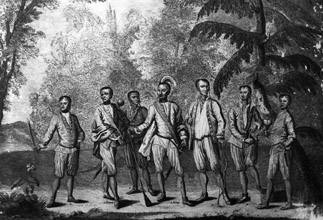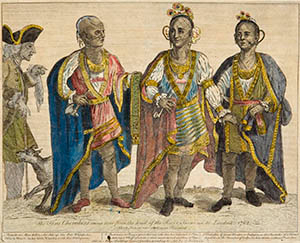British Delegation of Cherokees
 In April 1730, Sir Alexander Cuming (1690 - 1775) asked the Cherokees to pledge their allegiance to King George II of England. Sir Cuming convinced seven Cherokee warriors to immediately board a ship and visit with the King in London. They were shown about town, taken to the opera, and British women loved the exotic warriors. The delegation was entertained by the King for three lively months, and presented him with crown of eagle feathers.
In April 1730, Sir Alexander Cuming (1690 - 1775) asked the Cherokees to pledge their allegiance to King George II of England. Sir Cuming convinced seven Cherokee warriors to immediately board a ship and visit with the King in London. They were shown about town, taken to the opera, and British women loved the exotic warriors. The delegation was entertained by the King for three lively months, and presented him with crown of eagle feathers.
 Regarding equality, Timberlake was shocked that the Cherokee would "allow their women full liberty, without fear of punishment." while Attakullakulla asks, "Since white men, as well as red, were born of women, is it not the custom of the white people to also admit their women into the council?"
Peace Chief Attakullakulla was known to the whites as the "Little Carpenter." He was the youngest of the seven Cherokees who accompanied Sir Alexander Cuming to England in 1730. Oconostota was his cousin as well as his father-in-law.
Regarding equality, Timberlake was shocked that the Cherokee would "allow their women full liberty, without fear of punishment." while Attakullakulla asks, "Since white men, as well as red, were born of women, is it not the custom of the white people to also admit their women into the council?"
Peace Chief Attakullakulla was known to the whites as the "Little Carpenter." He was the youngest of the seven Cherokees who accompanied Sir Alexander Cuming to England in 1730. Oconostota was his cousin as well as his father-in-law.
King George II pledged: "A chain of friendship between the King of Great Britain and the Cherokee nation is like the sun which shines both here and also upon the great mountains where they live. The king has fastened one end of the chain of friendship to his own breast, He desires you to carry the other end to your wise old men nevermore to be broken or made loose. The indians and the english may live together as the children of one family as long as the mountains and river shall last, or the sun shine."
 Throughout North America's early history, the British had a favorable trade relationship with the Cherokee Nation. That relationship became strained during three years of the French and Indian War, when the Cherokee found themselves in the middle of the dispute between the British and the French. Both sides wanted peace, so an exchange of delegates took place in 1762.
Throughout North America's early history, the British had a favorable trade relationship with the Cherokee Nation. That relationship became strained during three years of the French and Indian War, when the Cherokee found themselves in the middle of the dispute between the British and the French. Both sides wanted peace, so an exchange of delegates took place in 1762.
The two cultures traded their finest clothing, pottery, beads, and baskets. Some British items, such as muskets, eye glasses, and clocks, completely altered the lifestyle of the Cherokee. It didn't take long for the Cherokee to abandon their traditional deer skin clothing in favor of the European clothes. Traditional Cherokee pottery and other tools were replaced by metal versions which were stronger and much more durable.
Although the two distant societies found much in common, the European view of the Native Americans was somewhat tainted. Timberlake reported that he was treated in "a very kind manner by the hospitable, though savage, people." I guess he never considered the circumstances under which the Native Americans were acting as "savages." If soldiers showed up and started raiding your home, you would be acting like a savage too.
 In May of 1762, Cherokee Warrior Chief Ostenaco of Tommotley, along with Man Killer and Pouting Pigeon, traveled to London for an audience with King George III. Lieutenant Henry Timberlake acted as an interpreter between the three Cherokee men and the king, though many accounts say they mostly used a form of sign language. Prior to the journey, Timberlake spent three months living among the Cherokee in what is now the states of Tennessee and North Carolina. Timberlake's memoirs (published in 1765 near the time of his death at age 29) contain a detailed account of the Cherokee culture as it existed in the 18th century.
In May of 1762, Cherokee Warrior Chief Ostenaco of Tommotley, along with Man Killer and Pouting Pigeon, traveled to London for an audience with King George III. Lieutenant Henry Timberlake acted as an interpreter between the three Cherokee men and the king, though many accounts say they mostly used a form of sign language. Prior to the journey, Timberlake spent three months living among the Cherokee in what is now the states of Tennessee and North Carolina. Timberlake's memoirs (published in 1765 near the time of his death at age 29) contain a detailed account of the Cherokee culture as it existed in the 18th century.
When asked about their trip across the ocean, Ostenaco said that "the head warrior of the canoe who brought us over the wide water used us very well."
On the subject of leadership, Ostenaco understood a monarchy where "the king commands over all next to the Man Above, and nobody is his equal." while Timberlake was impressed that "the Cherokee government is a mix of aristocracy and democracy with leaders chosen by merit."
Ostenaco is also known as Cunne Shote, Cumna Catogue, and Stalking Turkey. He was often confused with his uncle who was Standing Turkey. According to the writings by John Mooney, his Cherokee name is Aganstata. His tombstone in Chota, Tennessee says, "Oconastota - Great Warrior of the Cherokees"

For more information, Wikipedia has a page devoted to the history of the Cherokees: en.wikipedia.org/wiki/Cherokee_history